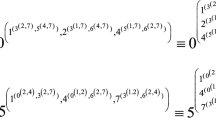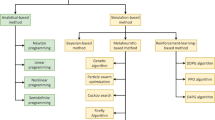Abstract
Linearization and planarization of the circuit models is pivotal to the submicron technologies. On the other hand, the characteristics of the VLSI circuits can be sometimes improved by using the multivalued components. It was shown that any ℓ-level circuit based on the multivalued components is representable as an algebraic model based on ℓ linear arithmetic polynomials mapped correspondingly into ℓ decision diagrams that are linear and planar by nature. Complexity of representing a circuit as the linear decision diagram was estimated as O(G) with G for the number of multivalued components in the circuit. The results of testing the LinearDesignMV algorithm on circuits of more than 8000 LGSynth 93 multivalued components were presented.
Similar content being viewed by others
REFERENCES
International Technology Roadmap for Semiconductors, San Jose: Semicond. Ind. Ass., 1998.
Kim, H. and Zhou, D., Efficient Implementation of a Planar Clock Routing with the Treatment of Obstacles, IEEE Trans. CAD Integrated Circuits Syst., 2000, vol. 19, no. 10, pp. 1220–1225.
Feinberg, V., Levin, A., and Rabinovich, E., VLSI Planarization: Methods, Models, Implementation, Boston: Kluwer, 1997.
Kawahito, S., Ishida, M., Nakamura, T., and Kameyma, M., High-Speed Area-Efficient Multiplier Design Using Multiple-Valued Current-Mode Circuits, IEEE Trans. Comput., 1994, vol. C-28, no. 1, pp. 34–41.
Computer Science and Multiple-Valued Logic, Rine, D.C., Ed., Amsterdam: North Holland, 1977.
Shmerko, V. and Yanushkevich, S., Fault Detection in MVL Networks by New Type of Derivatives of MVL Functions, Proc. Eur. Conf. on Circuit Theory and Design, Switzerland, 1993, pp. 643–646.
Shmerko, V., Yanushkevich, S., and Levashenko, V., Techniques of Computing Logic Derivatives for MVL Functions, IEEE Proc. 26th Int. Symp. on Multiple-Valued Logic, Spain, 1996, pp. 267–272.
Shmerko, V., Yanushkevich, S., Levashenko, V., and Bondar, I., Test Pattern Generation for Combinational MVL Networks Based on Generalized D-algorithm, IEEE Proc. 27th Int. Symp. on Multiple-Valued Logic, Canada, 1997, pp. 139–144.
Yanushkevich, S., Arithmetical Canonical Expansions of Boolean and MVL Functions as Generalized Reed-Muller Series, Proc. IFIP WG 10.5 Workshop on Applications of the Reed-Muller Expansions in Circuit Design, Japan, 1995, pp. 300–307.
Drechsler, R., Verification of Multi-Valued Logic Networks, Int. J. Multiple-Valued Logic, 1998, vol. 3, pp. 77–88.
Jain, A.K., Bolton, R.J., and Abd-El-Barr, M.H., CMOS Multiple-Valued Logic Design. Part I: Circuit Implementation. Part II: Function realization, IEEE Trans. Circuits Syst., 1993, vol. 40, no. 8, pp. 503–522.
Bohman, D., Stankovich, R., Toshich, Zh., Shmerko, V., and Yanushkevich, S.N., Differential Logic Calculus: Advances, Tendencies, and Applications, Avtom. Telemekh., 2000, no. 6, pp. 156–170.
Lipton, R.J. and Tarjan, R.E., Applications of Planar Separator Theorem, SIAM J. Comput., 1980, vol. 9, no. 3, pp. 615–627.
Beynon, M. and Buckle, J., On Planar Monotone Computation of Boolean Functions, Theor. Comput. Sci., 1987, vol. 53, pp. 267–279.
Nakajima, M. and Kameyama, M., Design of Highly Parallel Linear Digital System for ULSI Processors, IEICE Trans., 1993, vol. 7, no. E76–C, pp. 1119–1125.
Muroga, S. and Ibaraki, T., Design of Optimal Switching Networks by Integer Programming, IEEE Trans. Comput., 1972, vol. C-21, no. 6, pp. 573–582.
Sasao, T. and Butler, J.T., Planar Decision Diagrams for Multiple-valued Functions, Int. J. Multiple-Valued Logic, 1996, vol. 1, pp. 39–64.
Bryant, R. and Chen, Y., Verification of Arithmetic Functions Using Binary Moment Diagrams, Proc. Design Automat. Conf., 1995, pp. 535–541.
Antonenko, V.M., Ivanov, A.A., and Shmerko, V.P., Linear Arithmetic Forms of the k-Valued Logic Functions and Their Realization on Systolic Arrays, Avtom. Telemekh., 1995, no. 3, pp. 139–155.
Strazdins, I., The Polynomial Algebra of Multivalued Logic, Algebra, Combinatorics, Logic Comput. Sci., 1983, no. 42, pp. 777–785.
Malyugin, V.D., Realization of the Corteges of Boolean Functions by Linear Arithmetic Polynomials, Avtom. Telemekh., 1984, no. 2, pp. 114–121.
Malyugin, V.D., Realization of the Boolean Functions by Arithmetic Polynomials, Avtom. Telemekh., 1982, no. 4, pp. 84–93.
Malyugin, V.D., Parallel'nye logicheskie vychisleniya posredstvom arifmeticheskikh polinomov (Parallel Logic Calculations by Arithmetic Polynomials), Moscow: Nauka, 1997.
Komamiya, Y., Theory of Relay Networks for the Transformation Between the Decimal and Binary System, Bull. E.T.L., 1951, vol. 15, no. 8, pp. 188–197.
Sasao, T., Switching Theory for Logic Synthesis, Boston: Kluwer, 1999.
Stankovic, R.S. and Drechsler, R., Circuit Design from Kronecker Galois Field Decision Diagrams for Multiple-Valued Functions, IEEE Proc. 27th Int. Symp. on Multiple-Valued Logic, 1997, pp. 275–280.
Minato, S., Binary Decision Diagrams and Applications for VLSI CAD, Boston: Kluwer, 1996.
Author information
Authors and Affiliations
Rights and permissions
About this article
Cite this article
Dziurzanski, P., Malyugin, V., Shmerko, V. et al. Linear Models of Circuits Based on the Multivalued Components. Automation and Remote Control 63, 960–980 (2002). https://doi.org/10.1023/A:1016125907861
Issue Date:
DOI: https://doi.org/10.1023/A:1016125907861




